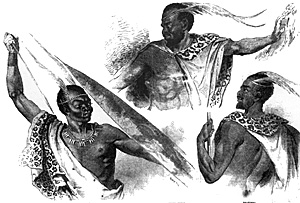 The principal opponents of the British in the Cape Frontier Wars
were the Xhosa, a Bantu people who lived on the eastern border of
Cape Colony. They were divided into two groups: the Gcaleka, who
lived to the east of the Kei River; and the Ngqika (or Gaika),who
inhabited the land between the Kei and Fish Rivers. This division was
the result of a dispute in the early nineteenth century over the powers
of the Xhosa paramount chief, which ended when those tribesmen who
refused to accept his authority migrated to the land west of the Kei. It
was this group, the Ngqika, who bore the brunt of the conflict with the
British.
The principal opponents of the British in the Cape Frontier Wars
were the Xhosa, a Bantu people who lived on the eastern border of
Cape Colony. They were divided into two groups: the Gcaleka, who
lived to the east of the Kei River; and the Ngqika (or Gaika),who
inhabited the land between the Kei and Fish Rivers. This division was
the result of a dispute in the early nineteenth century over the powers
of the Xhosa paramount chief, which ended when those tribesmen who
refused to accept his authority migrated to the land west of the Kei. It
was this group, the Ngqika, who bore the brunt of the conflict with the
British.
Under the Xhosa military system, every able bodied adult male was a warrior. Each man was armed with a bundle of seven or eight light throwing spears, and either a knobkerrie or wide-bladed assegai for use in hand-to-hand combat. John Shipp, then a private of the 22nd Foot, wrote:
"They are ... such expert marksmen with their darts
(throwing spears) that they can be certain of their aim at sixty, or
seventy, paces distance (50-60 yards) ... Before they deliver the darts
.. . they run sideways for a little way, the left shoulder for-ward, and
the right considerably lowered, with the right hand extended behind
them, the dart lying flat in the palm of the hand, the point of it being
near the right eye. When thrown it flies with such speed that you can
scarcely see it." (1)
Large oval shields, made of cowhide, were carried as late
as the 9th Cape Frontier War (1877-78), but were not common, for
they could not stop British bullets and were an encumbrance in the
bush. A warrior was far more likely to rely on his bullock hide cloak,
wrapped round the left arm and held across the body, for protect ion in
hand-to-hand combat.
Although, by the 1840s, the Xhosa were well supplied
with muskets, which they obtained from gun-runners or dead white
men, they had, as a British soldier observed:
"but very little knowledge of the use of firearms. Very
few of them fired their gun from the shoulder but discharged it from the
hip, with the muzzle elevated so much that their shots nearly all went
over our heads. They had not the most remote idea what quantity of
powder was necessary for one charge. They would empty the powder
from a bullock horn into the palm of the hand and pour it into the
barrel. They were equally ignorant in reference to shot. Anything that
could be got into the barrel was satisfactory to them. It was evident
that however well they might be off for powder, they were very short
of ball, particularly lead. A great portion of their shot was made of
zinc, with the casting nipple uncut, (and) chain links cut in pieces of
various lengths." (2)
The Xhosa began to acquire horses in the 1830s, but
they never developed a cavalry arm, for they considered it impractical
in bush warfare. Chiefs and scouts, however, were often mounted for
extra mobility.
Early Battles
Two areas, the Amatolaand Kroome Mountains, were of particular
importance, for the Xhosa used them as "safe bases," and concealed in
them their crops, cattle and families. The Amatola Mountains lay to
the east of the Fish River, and consisted of a circular range of hills,
about forty miles in circumference and thirteen or fourteen in
diameter. These hills were "of no great elevation, but sufficiently
prominent, in a country otherwise comparatively open, to be called
mountains."
From the outer circle of hills, numerous spurs branched inwards
towards the centre. Between these spurs lay deep, densely wooded
ravines, or kloofs, which provided ideal hiding places for guerrillas. The
tops of the hills and spurs, however, were generally free of woodland,
which gave "the country a park like appearance." (3)
The second of these "safe bases," the Kroome Mountains, lay to
the west of the Fish River, and consisted of a number of spurs separated
by six or seven deep, densely wooded ravines. These were several miles
in length, and radiated out in all directions from a central point.
(4)
Xhosa Tactics
The most commonly used tactic in the Xhosa repertoire
was the ambush, which invariably took the form of a sudden burst of
firing from the bush. The long, slow moving trains of ox-wagons that
the British used to supply their garrisons and field forces were
particularly vulnerable to such attacks, and they inevitably became the
object of the tribesmens attentions. One very successful ambush took
place on 17 April 1846, at the commencement of the 7th Cape
Frontier War: a train of 125 wagons, stretching for over three miles,
but escorted by only 140 men of the 91st Foot and 7th Dragoon
Guards, was wending its way along the banks of the Keiskama River,
when the Xhosa suddenly opened fire from the bush on both sides of
the track.
The leading wagons were so well protected that they got
through safely, but those in the centre were less fortunate; their escort
was driven back onto the advance-guard at the front of the column,
and the Xhosa, emerging from the bush, immobilised them by cutting
loose the draught oxen. Since the road was now blocked, the fifteen
dragoons who constituted the rear-guard had no option but to abandon
the wagons in their care and fight their way to the head of the column.
This they did, but although the combined forces were able to hold their
own until help arrived, fifty-two wagons and their loads were lost as a
result of this ambush. (5)
"A great number of cattle having been seen passing over
a ridge within sight of our Camp, a party of Dragoons and C.M. Rifles
were ordered off in pursuit under the command of Captain Bambrick,
7th Dragoon Guards.
They had not proceeded far when they perceived the
enemy approaching on all sides. The cattle had only been driven over
the ridge as a decoy. The Officer gave the order for the Troops to
retire a short distance as the bush was too thick for the movements of
mounted men and I have no doubt intended to get on more open
ground, thinking perhaps he might induce the enemy to come
somewhat more into the open.
He had scarcely given the order when he was shot and
fell head foremost over the front of the saddle ... An attempt was
made to recover the body, but they were not successful. The bush was
too thick and the number of the enemy was increasing, and the party
thought it advisable to return to camp."
(6)
Although the Xhosa never attacked at night,
they were much given to marauding and petty harassment during the
hours of darkness, when they would crawl "forward on ... hands and
knees, and keeping touch ... by imitating the cries of animals which
are well understood by them. At the smallest noise they will flatten
themselves on the ground, so that you can pass close by without seeing
them; and then the first indication you have of such dangerous
neighbours is the thrust of a spear, or the blow of a club ... We kept a
smart watch, but even then it was nothing unusual to see a spear lodged
in the top of a wagon next morning, close to the place where a look-
out man had stood." (7)
8th Frontier War
During the 8th Cape Frontier War, the Xhosa had a
number of disaffected Hottentots from Cape Colony as allies. Many
were trained and disciplined deserters from the Cape Mounted Rifles, a
locally raised mounted infantry unit, for the Hottentots had hitherto
been staunch allies of the British. Well armed and mounted, they now
became the terror of the colony well within the border. In mixed bands
50-100 strong, they and their Xhosa allies issued forth from secure
haunts on raids, plundering the flocks and herds in the surrounding
districts, and, in spite of all precautions, and some severe encounters
and loss of life, more often than not made off with their booty to a
place of safety. (8)
The Basotho military system resembled that of the Zulus
in that their army was divided into named regiments, each formed from
men of the same age group. Armament consisted of light throwing
spears, battle axes, curiously shaped cowhide shields with two
projecting wings and, by the 1850s, a large number of guns. These,
however, were often obsolete and of the poorest quality. The Basotho,
moreover, had little idea of how to use firearms, and were short of
both powder and shot.
The Basotho were unique amongst the black peoples of
southern Africa in that they possessed a cavalry arm. The latter were
armed in the same way as the infantry, and mounted on small, sure
footed "Basotho" ponies, which were ideally suited to a hilly
environment. (9)
The British had fought guerrilla-type raiders e.g. the
Pindaris of west and central India, before, and they knew that the only
way to inflict serious loss upon them was to surprise them in their
camps. Since irregular warriors seldom protected themselves with
outposts during the hours of darkness, a night march, followed by an
attack at daybreak, was the most effectual means of achieving surprise.
But in the thick bush and dense forests of the Cape frontier, night
marches were frequently impractical, and always difficult to execute, as
the 74th Foot found when they attempted to surprise a Hottentot
kraal (village) in June 1851. The ground which the regiment had to
traverse en route was, one officer wrote:
"Most difficult, abounding for the first few miles in deep
holes and innumerable ant-hills; after which, it became, if possible,
worse; entering a narrow rugged descending defile, a succession of deep
steps or ledges cut through a thick bush, and intersected by sluits or dry
watercourses (large and deep enough, as we very soon found, to contain
three or four men at once), and thickly strewn with large stones and
loose rocks, over which we stumbled and fell at almost every step, five
or six being frequently down at once, and often sustaining severe cuts
or bruises.
As we were descending a very steep path ... the forces
got separated in the darkness of the night, and being unacquainted with
the country, one company was completely lost in the bush; while
another wandered so far out of the way as to cause great delay in
commencing operations.
We approached the enemy's position just as the day
began to dawn, and found our advance retarded by a large barricade of
newly felled trees, thrown across the narrow path at a point where the
bush on either hand was perfectly impenetrable. This obstruction again
delayed us a considerable time, as all were obliged to file through an
opening cut through the close thorny bushes . . ."
(10)
Delays
These delays had a serious effect on the outcome of the action
which followed, as the British had intended to station some mounted
troops across one of the enemy's escape routes, "which they were to
reach by riding noiselessly along the inner margin of the bush; but as
the day was approaching there was every chance of their being
discovered, consequently the plan was abandoned, and they remained
with the infantry . . ." Thus, the Hottentots, after making only a brief
stand, were able to escape "by the very outlet which was to have been
held by the mounted force. Had it been so occupied scarcely a man
would have escaped them. As it was, the dense and extensive bush
rendered all pursuit hopeless." (11)
Since there was little chance of bringing the Xhosa to
battle in their native terrain, the British concentrated, from the 7*,h
Cape Frontier War onwards, on depriving them of food and shelter.
The chosen means of achieving this objective was the concentric
attack, in which several columns converged on the Amatola or
Kroome Mountains from different directions, meeting at some pre-
arranged point. Although the very difficult nature of the wooded ridges
and ravines was such as to prevent heavy loss being inflicted on the
Xhosa themselves, they were always totally dispersed, their kraals
burnt, their crops destroyed, and large numbers of their cattle driven
off. (12)
In the thick bush and dense forest of the Cape frontier,
all infantry fought as light infantry, as they did in the mountains of
Afghanistan during the First Afghan War. During the above mentioned
attack on the Hottentot kraal, the 74th Foot, a line battalion, "on
gaining the open space took 'skirmishing order;' two companies
extended, two in support, and the remainder in reserve;" (13) and in another action, we hear of
"two companies of the 74th and two of the 74th advancing in
skirmishing order."
(14)
The Xhosa, however, seem to have regarded properly
constituted light infantry as more formidable opponents than line
infantry acting as such. The Rifle Brigade, for example, "were the very
terror of all Kaffirs, who dreaded the sight of a Zwart Badjie- Black
Jacket." (15)
On the Cape frontier, it was always necessary for a
column to be protected by flanking parties while on the march, for the
Xhosa rarely engaged a body of troops frontally, preferring instead to
operate against their flanks and rear. Long range sniping was not a
problem in the bush, so these flanking parties were posted close in to
the main column, not several hundred yards out, as would have been the
case in mountain warfare. They could be stationary, in which case they
were detached from the advance-guard as it moved for-ward; or they
could move parallel to the column if the bush was not too thick.
As in all counterguerrilla campaigns, tactical success in
the Cape Frontier Wars was obtained by turning the enemy's own
tactics, e.g. the ambush, against him. This some regiments were able to
do. The 73rd Foot, for example, evolved their own drill for an ambush:
a few men, preferably positioned at a bend in the track, would fire a
single volley as soon as the enemy were at pointblank range. Then, the
remainder of the troops, disposed along one side of the track and
parallel to it, would charge. (17)
The 74th Foot, too, were capable of playing the Xhosa at their own
game, as Captain King relates:
"Some of our men lying flat on the large slabs of stone,
and peering down into the deep forest on the sloping mountain side,
made signs to me, pointing below, and quietly reaching their position, I
had an opportunity rarely afforded of watching a party of Kaff irs
cautiously advancing along the bottom of the thicket immediately
below us, creeping stealthily through the under-wood, perfectly naked
and armed with assegais and guns.
Stopping every few feet to listen, they peered into the
bush before them, their well greased bodies shining in the occasional
gleams of sunshine that streamed down through the thick foliage of the
trees, and again moved on, avoiding every rotten twig, and preserving a
noiselessness perfectly marvellous ... Our men waiting the moment to
fire, had gradually brought the muzzles of their arms to bear; and
without moving their heads, and hardly drawing breath, silently
indicated to each other the whereabouts of fresh comers.
With rifles pointed through the creepers at the edge of
the rock on which we lay stretched, we waited with fingers on the
trigger for a fair shot, and I fancied I could hear my heart beating. At a
signal, bang went twenty muskets, echoing from crag to crag in the
silent wood, and the treacherous savages met the death they had been
plotting for us." (18)
In thick bush or forest, where fighting almost always
took place at comparatively close quarters, the bayonet was an
important weapon of defence, as Sir James Alexander pointed out in
the 6th Cape Frontier War (1835):
"It is certainly no child's-play tracking through the
dense bush by a narrow path in Indian file, having a volley of
musquetry suddenly poured on the party from above, and stalwart and
naked warriors rushing with yells and stabbing assegais from the
elephant grass around; and though one is constantly liable to this in
Kaffir warfare, yet, strange to say, neither the sword nor short lance
had been thought necessary for troops liable to be exposed to these
emergencies, and very few of the arme blanche were found in the Cape
armoury. Though all the musquets issued to the Hottentots had
bayonets, yet they absurdly threw them aside as useless encumbrances."
(19)
Section 2: More British Tactics
This article appears in MagWeb (Magazine Web) on the Internet World Wide Web.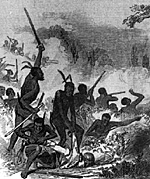 In their early battles against the Europeans the Xhosa fought in
the open, using a formation similar to the Zulu "beasts horns", though,
unlike the Zulus, they did not usually attempt to close with the enemy.
These traditional tactics were soon abandoned in the face of European
firepower, and replaced by those of guerrillas. The terrain of the Cape
frontier was well suited to guerrilla warfare: much of it consisted of
thick bush, which greatly hindered the movements of conventional
troops, while providing plentiful cover for their lightly equipped
enemies.
In their early battles against the Europeans the Xhosa fought in
the open, using a formation similar to the Zulu "beasts horns", though,
unlike the Zulus, they did not usually attempt to close with the enemy.
These traditional tactics were soon abandoned in the face of European
firepower, and replaced by those of guerrillas. The terrain of the Cape
frontier was well suited to guerrilla warfare: much of it consisted of
thick bush, which greatly hindered the movements of conventional
troops, while providing plentiful cover for their lightly equipped
enemies.
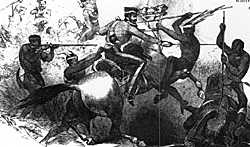 Another ploy favoured by the Xhosa was the
employment of individual warriors or herds of cattle as decoys to lure
detachments of British troops into the bush, where they could be cutoff
and surrounded by superior numbers of warriors. A private of the 7th
Dragoon Guards described how this stratagem was used to draw a
detachment of his fellow dragoons into a trap:
Another ploy favoured by the Xhosa was the
employment of individual warriors or herds of cattle as decoys to lure
detachments of British troops into the bush, where they could be cutoff
and surrounded by superior numbers of warriors. A private of the 7th
Dragoon Guards described how this stratagem was used to draw a
detachment of his fellow dragoons into a trap:
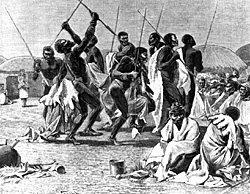 In June 1851 and December 1852, the British dispatched
military expeditions against the Basotho, who lived 100 miles beyond
the Orange River, the northern boundary of Cape Colony. The
Basotho were descended from a Sotho clan, which had been driven
from it's lands during the Mfecane, (the series of wars that
accompanied the rise of the Zulu empire in the 1820s), and which
eventually settled on a large flat-topped hill called Thaba Bosiu in the
Drakens berg Mountains.
In June 1851 and December 1852, the British dispatched
military expeditions against the Basotho, who lived 100 miles beyond
the Orange River, the northern boundary of Cape Colony. The
Basotho were descended from a Sotho clan, which had been driven
from it's lands during the Mfecane, (the series of wars that
accompanied the rise of the Zulu empire in the 1820s), and which
eventually settled on a large flat-topped hill called Thaba Bosiu in the
Drakens berg Mountains.
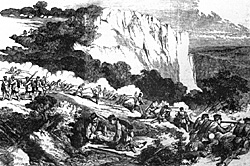 This was the procedure adopted by the 73rd Foot, whose
flankers usually moved on either side of the path, looking up into trees
and down into thickets. Where the bush was too thick to admit of
mobile flankers, the regiment moved in single file and, at every halt,
the men moved a few paces into the bush, turning outward, the leading
man to the right, the next to the left etc.
(16)
This was the procedure adopted by the 73rd Foot, whose
flankers usually moved on either side of the path, looking up into trees
and down into thickets. Where the bush was too thick to admit of
mobile flankers, the regiment moved in single file and, at every halt,
the men moved a few paces into the bush, turning outward, the leading
man to the right, the next to the left etc.
(16)
Back to Age of Empires Issue 14 Table of Contents
Back to Age of Empires List of Issues
Back to MagWeb Master List of Magazines
© Copyright 1998 by Partizan Press.
Other military history articles and gaming articles are available at http://www.magweb.com